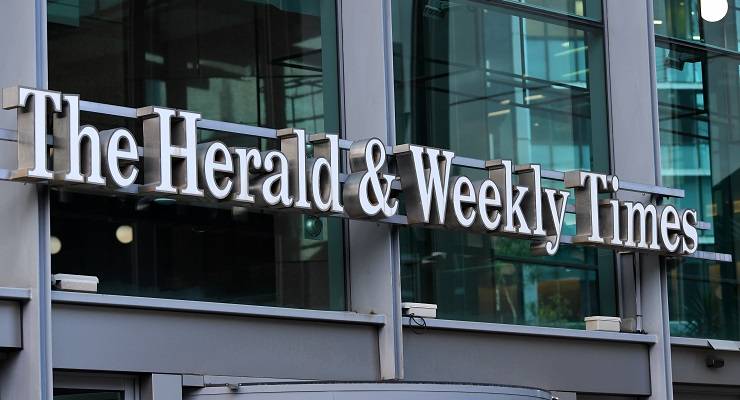
Today’s News Corp conflagration of the venerable regional mastheads from northern NSW and Queensland marks the tipping point where printed newspapers will now endure as a nostalgic luxury good for those few communities that can afford them.
Among the 100-plus titles slated for shutting are almost half of all Australia’s regional newspapers — 12 dailies out of its 17, leaving no daily papers along the more than 2000km-long regional strip between Newcastle and Townsville. Only the Gold Coast Bulletin and Courier-Mail in the heavily-populated south-east corner of Queensland will be in between.
Many suburban newspapers suspending print early in the COVID-19 crisis. Now most of them are, unsurprisingly, confirmed as shutting.
The papers that endure in print (for the time being at least) are those that service communities well off enough to wring out the last remaining advertisers dollars — papers like the Chronicle in comfortable Toowoomba, or the Wentworth Courier in Sydney’s wealthy eastern suburbs.
News Corp claims it will fill the gap through digital news at both the regional and local level. It promises to ensure its metropolitan tabloids — which have been increasingly nationalised with shared copy to save costs — will return to a state (and regional) focus.
But like all commercial media News Corp is a business. This more limited regional news network will diminish over time, with any lingering news output focusing on communities that remain wealthy enough to attract advertising dollars.
This means that in regional Australia local news will soon follow print as a luxury, with only the ABC filling the gap left by commercial market failure.
The closures are said to be costing up to 1000 jobs, most of them in regional Australia. Back of the envelope suggests these closures will see about two-thirds of the journalists across the company’s regional and local network go.
Traditionally, News Corp has only withdrawn from markets with deep reluctance, always trying to keep some simulacra of the closed product ticking over just in case.
In 1990, when the company closed its afternoon papers — The Daily Mirror in Sydney and The Herald in Melbourne — it temporarily filled the gap with late-morning editions of the newly branded Daily Telegraph-Mirror and Herald Sun. These closed about five years later and the Telegraph dropped the Mirror from its masthead.
Similarly, when the company was forced to close London’s News of the World due to the phone-hacking scandal, it filled the gap with a Sunday edition of its daily The Sun.
Despite the best intentions of the company, this gap-filler mix of local digital hubs and more state-based tabloids is unlikely to long endure the disruption of news media.
Expect those surviving job numbers to diminish over time.
This reluctance to give up any remaining dollars seems to be what got in the way of talks to sell the closed mastheads to Antony Catalano’s Australian Community Media (ACM), to match the regional and local papers ACM bought from Nine last year following the Fairfax take-over.
It seems News Corp wanted to keep any mastheads that still made money and compete with ACM in the digital space. Even at the sell price of media companies at $1, this wouldn’t have been an attractive deal.
Media historians will also note that the company has effectively closed the old O’Reilly owned APN Media — the chain of regional papers that News Corp bought for about $36 million in 2016.
Many of the papers dated back to the 19th century, having been put together in a regional chain by the Queensland Newspapers, itself once owned by the first Murdoch, Sir Keith, before being sold to the The Herald and Weekly Times to pay estate taxes when he died.
In the Queensland Newspaper’s Bowen Hills offices it’s an article of faith that Queensland has a special place in the Murdochs’ heart.
Maybe now not so much.
Meanwhile, across the Tasman, New Zealand newspapers may have got a new lease of life this week when Nine finally sold Stuff — along with daily newspapers like Wellington’s Dominion Post and Christchurch’s The Press — to local management.
The sale price? One dollar.








Personally having not bought a newspaper in years I couldn’t give a stuff if all the mainstream right-wing media collapsed and all their Murdoch arse licking journos get thrown onto Newstart, they`ve bagged the unemployed for years and called them dole bludgers so let’s see how they take some of their own medicine, the next good news will be Murdoch’s funeral announcement.
Schadenfreude is delicious cold.
At least these rags of filth and hate are gone forever. Hopefully to be soon followed by the surviving “pamphlets” left in the big cities. Lies Ltd is a stain on humanity and it’s demise can only be good.
News Corp is a cancer that has metastasised throughout the body of professional journalism in Australia, Britain and the US. It has finally killed its host in this country. The only good that we can hope comes of it is that the cancer dies too.
Every time I come near Sky or Fox News, I realise again that News Corp is about as close to pure evil as you can get. There is no greater force working to dismantle our democracy.
I’m still prepared to pay for news I trust, as I suspect many people are. I subscribe to Crikey, I donate to The Conversation and I watch and listen to the ABC. For a local slant, I’m a member of three Facebook groups that reflect my neighbourhood: one for my suburb, one for a six-suburb amalgamation that adjoins my suburb, and a general one for my side of town. Through these groups, I can talk directly with my neighbourhood, share information, and access local services. I’m willing to bet that most of the regional centres that have lost their local newspaper have something similar.
“Real’ journalists may choose to sneer at Facebook, but there’s a reason it is in the ascendency as the print medium fades. And should it transpire that FaceBook can’t fill the gap left by those disappearing newspapers, then I am confident they will rise again – this time, hopefully, without the Murdoch stench attached to them.
Spot on Graeski. Legacy journalists need to get their heads out of their bums and recognise just how loathed – loathed – they are. Then they need to ask themselves ‘why?’.
It’s not because we’re nasty, ignorant and selfish. It’s because journalism has become a bully in all the wrong ways and directions. Punching down and kissing up, and not telling us the truth about our world.
Am I sad that some good journalists are losing their jobs? Only in the same way that I’ll be sad that some good people in Trump’s White House will lose theirs, if he’s not really-elected. That ‘if’ (rather than ‘when’) says a lot about how badly newspaper journalism has failed to do what it arrogantly and endlessly claims to do: speak truth to power. Lamestream, fake news meeja, indeed.
Newspaper – and TV – journalism is dead. Hooray, hooray, hooray. Long live journalism.
Can’t say I’m not with you Jack. Can only add that The Australian, run by a yank with a poisonous yank mindset, is also a regional masthead. When that goes Rupert is a dinosaur. His demise is my celebration.